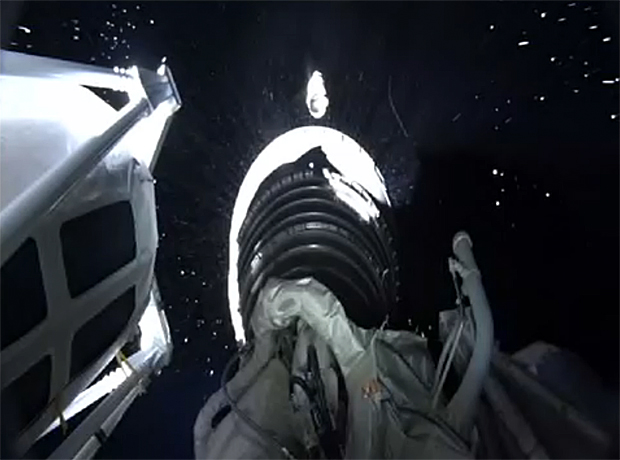Atlas 5 rocket boosts powerful Mexican comsat into space
Four and a half months after a Russian launch failure destroyed a $300 million Mexican communications satellite, a United Launch Alliance Atlas 5 rocket boosted a second, equally costly relay station into space Friday to provide high speed data, video and cellular services across Mexico.
Joining a smaller Mexican communications station already in orbit, the Morelos 3 relay station will anchor the $1.6 billion MexSat network and "fully meet national security and social connectivity functions in remote sites," Gerardo Ruiz Esparza, Mexico's minister of communications and transportation, told reporters before launch.
The towering 195-foot-tall Atlas 5's Russian-built RD-180 first-stage engine thundered to life with a rush of fiery exhaust at 6:28 a.m. EDT (GMT-4), followed an instant later by ignition of two solid-fuel strap on boosters.
It was the 57th launch of an Atlas 5 since the rocket's maiden flight in 2002 and ULA's 100th flight since the company, a partnership between Boeing and Lockheed Martin, was formed in 2006 to market Delta boosters and Atlas 5s.
Running 20 minutes late because of a boat that strayed into the offshore danger zone, the Atlas 5 quickly climbed away from launch complex 41 at the Cape Canaveral Air Force Station, knifing through low clouds as it accelerated on 1.6 million pounds of thrust.
The strap-on boosters burned out and fell away a little more than two minutes into flight. The RD-180 continued firing for another two minutes before it, too, shut down and the first stage fell away. The Centaur second stage's hydrogen-burning Aerojet Rocketdyne RL10C engine then ignited to continue the ascent.
The first of two Centaur firings ended 18 minutes after liftoff. After a two-and-a-half-hour coast, the RL10C engine fired again for just under one minute to put the Morelos 3 satellite into the planned preliminary orbi with a high point, or apogee, of around 22,237 miles and a low point, or perigee, of 2,979 miles.
The satellite then separated from the Centaur to complete the launch phase of the mission. On-board thrusters will be used over the next 13 days to raise the low point of the spacecraft's orbit, eventually putting Morelos 3 into a circular orbit 22,300 miles above the equator. In such equatorial orbits, spacecraft take 24 hours to complete one trip around the planet and thus appear stationary in the sky.
ULA President Tory Bruno said the Atlas 5 hit a "bullseye" with the company's 100th launch, putting the satellite within a mile of the pre-launch orbit prediction. "I couldn't be more pleased," he said.
Built by Boeing Satellite Systems, Morelos 3, also known as MEXSAT 2, will use a giant 72-foot-wide mesh antenna and a smaller 7-foot-wide Ku-band antenna to provide 3G cellular services across Mexico, including education and health programing along with voice, data, video and internet services.
Morelos 3 originally was to have worked in tandem with Mexico's Centenario relay station -- MEXSAT 1 -- but those plans went up in smoke when the upper stage of a Russian Proton rocket malfunctioned during launch May 16, destroying the comsat. Including the cost of the Proton, the mission was insured for $390 million, according to Spaceflight Now.
The Atlas 5 is a more expensive rocket, typically used to launch U.S. national security satellites and NASA planetary probes. But the 11,685-pound Morelos 3 was too heavy for a SpaceX Falcon 9 rocket and Europe's Arianespace had no open slots. As it was, Friday's launching was only the 12th commercial flight of an Atlas 5.
Despite the May Proton failure, Esparza said Morelos 3 and the smaller MEXAST 3, launched in December 2012 by an Ariane rocket, would provide the service needed to make the MEXSAT network a success.
"In a country as ours with difficult geographic access and high population dispersion, satellite communications are essential tools for isolated people who live in communities where telecommunications infrastructure is not available," Esparza said.
"We need to count on voice, data and video services to grant them the same opportunities as those who live in areas with more access to these technologies."
Along with providing disaster relief and emergency services, the MEXSAT system also will improve national security, Esparza said, by increasing communications capacity and "optimizing the performance of their duties."
"A great number of Mexican engineers have been trained at the highest industrial standards to operate and control this satellite fleet," he said.
If all goes well, the Morelos 3 satellite will be turned over to Mexico's Ministry of Communications and Transportation for operational use next summer.
Editor's Note: This story includes reporting by Spaceflight Now.

